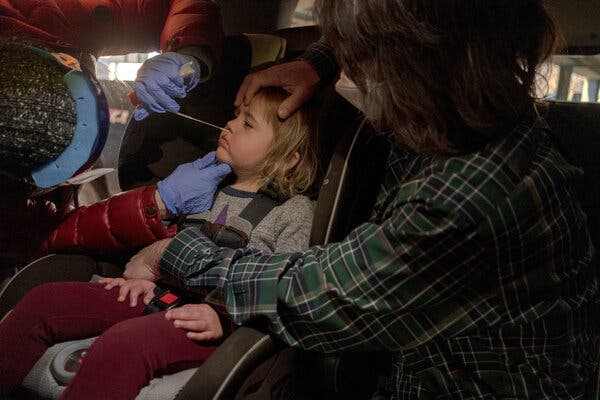HOUSTON — Twice last year, Margaret Schulte and her husband, Jason Abercrombie, traveled 11 hours round-trip to Louisiana from their home in Tulsa, Okla., in the hopes of vaccinating their children, who were 2 and 4, against the coronavirus.
The only way they could get shots for their children — among the more than 19 million Americans under 5 years old who are not yet eligible for vaccinations — was to take part in a clinical trial. So they signed up, hoping a successful vaccine would mean that by now, or at least sometime very soon, a semblance of prepandemic life would be on the horizon.
It has not worked out that way.
The Pfizer trial that their children participated in did not produce promising results, the company said last month. Nor have vaccines emerged from other corners. Moderna has yet to release results of its pediatric trials.
Now Ms. Schulte and Mr. Abercrombie are among the millions of parents stuck in an excruciating limbo during a surge of Omicron cases, forced to wrestle with day care closures and child care crises as the rest of the world appears eager to move on.
“I am actually home with my daughter right now,” Ms. Schulte, 41, who owns a garden store and is eight months pregnant, said when reached by phone this week. There had been a positive case at her 2-year-old’s preschool. “This is our fourth or fifth time being quarantined,” she said. “There’s no getting work done while she’s around.”
The nearly vertical rise of coronavirus cases in recent weeks has complicated the calculations of many families with children under 5, a population prone to the runny noses and coughs that now prompt waves of anxiety.
Tests are hard to come by. Day care providers are strained. There are roughly 110,000 fewer people working in child care now compared with February 2020, according to research from the University of California, Berkeley.
With child care interruptions mounting, parents of young children have again found themselves sequestered at home, staring out windows, wondering anew if the world cares about the seemingly impossible balancing acts they are having to perform.
“The stress just comes from seeing that the rest of society has kind of moved on, and then parents of young kids and the young kids themselves seem to be forgotten,” said Becky Quinn, a lawyer in New York. She and her husband found themselves stuck this week with both children and no child care in their one-bedroom Brooklyn apartment.
“First we got the notification on Saturday that the baby’s was closed. We were like, OK, we can make that work,” Ms. Quinn said. “Then on Sunday we heard that the 3-year-old’s class was closed. I just laughed at that point.”
Both she and her husband are able to work remotely, a privilege she acknowledged not everyone has. And her bosses have been understanding, she said. But it has still been difficult.
The convergence of repeated closures of day care centers and classrooms with the realization that a vaccine for young children could still be many months away has forced many parents to make uncomfortable choices, particularly women.
Aria Carter, who lives in rural Vermont, stepped back from her job as director of admissions for a school because of child care difficulties. Now she reads psychological evaluations for admissions, a role she can do at odd hours or while her 1-year-old son is napping and her 4-year-old son is at school.
“I can’t get him in day care, there’s no space,” Ms. Carter said of her toddler. “I don’t have any family where I live. It’s hard.” But she added that the spread of the Omicron variant meant she would not have felt comfortable putting him in day care anyway, and that she had enjoyed her time at home with him.
Shaneka Adewuyi, an office administrator for the Tulsa Police Department, said that at one point her day care center closed for six weeks because of a surge in cases. The challenge of juggling two young children, ages 1 and 2, along with a 9-year-old in virtual school, plus her job, is enough to bring Ms. Adewuyi to tears.
“It takes a toll on my mental health,” she said. “But the babies need to eat, they have to be rocked to sleep, they need a diaper change.”
For some parents, the abnormality of the pandemic began with pregnancies consumed by concern about the effects of infection or the vaccines. Routines have been altered for so long that many of their children have never experienced, or can no longer remember, how things were before a life of quarantines and masks.
Mr. Abercrombie, 39, said he was taken aback when his 4-year-old, Andy, did not want to play with other children at a playground. “He said they might have the sickness,” Mr. Abercrombie recalled. “How is that, to grow up if you think other children might give them the sickness?”
Vaccines, a key part of the federal response to the pandemic, have proven challenging to get right for young children. While shots are already available for those 5 and older, parents of children 4 and younger may have to wait months more for a vaccine that works.
Even when they are available, many parents may choose not to give them to their young children. Vaccination rates remain very low — under 20 percent — among the youngest eligible group, children who are 5 to 11 years old.
Young children are at much less risk of becoming severely ill after a coronavirus infection when compared with adults, doctors have said. While hospitalizations have gone up for children, the overall numbers remain very low.
In Austin, Texas, Kyle and Tasha Countryman count themselves among the lucky: They both have jobs that are busier than ever — in construction and furniture sales — and the day care where they send their children, who are 1 and 2, has closed certain classes only a couple of times during the pandemic.
They were very cautious while Ms. Countryman, 36, was pregnant. “None of us wanted to get sick before I delivered,” she said. Now, she said, her goal is to give the children as normal a life as possible. That means seeing family, friends and cousins and going out to places where masks are not required.
“We do that so our kids can see other kids’ faces,” Ms. Countryman said. “I don’t want to go to some of these indoor places if it’s going to be very, ‘Stand here and everybody wear masks.’ Those are not the places that we’re actively seeking out to spend our time. We’re going to more restaurants, breweries, activities that we can do outside.”
She said that she and her husband would not feel comfortable getting a coronavirus vaccine for their children right away, and would want to make sure that any risk of side effects did not outweigh the benefits.
For Ms. Schulte, whose two young children participated in the Pfizer vaccine trial, the promise of a new vaccine has given way to more waiting.
“They’ve already told us that we’ll need to come back for a third dose because it didn’t generate enough of an immune response,” she said.
“We had hoped that by now we would learn that one of our children was fully vaccinated and we could move on,” she said. “It would have been nice, but a trial is a trial.”



























